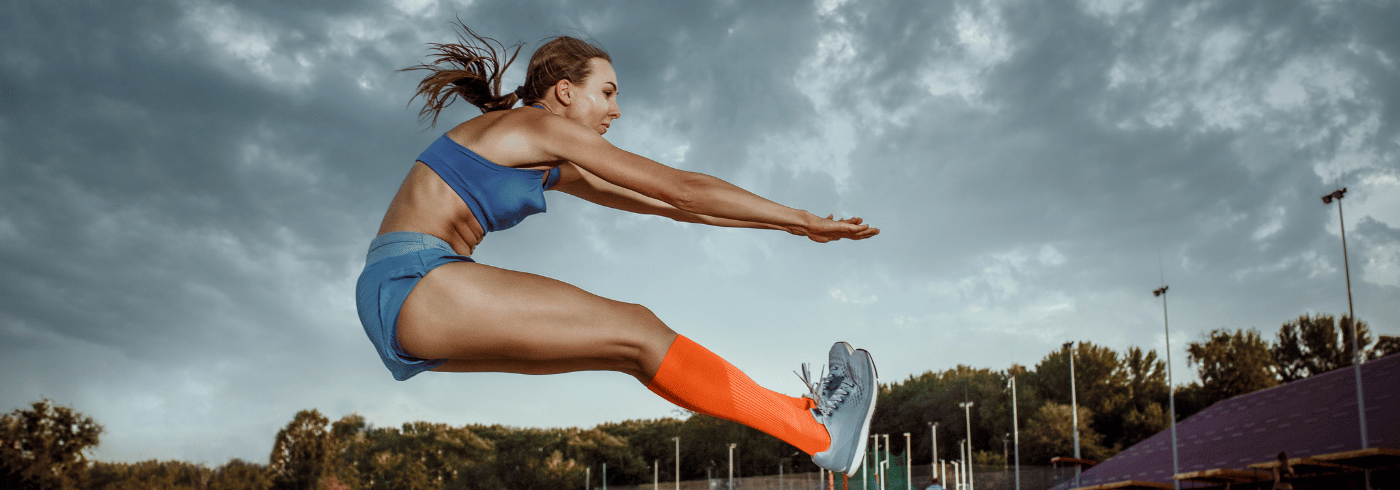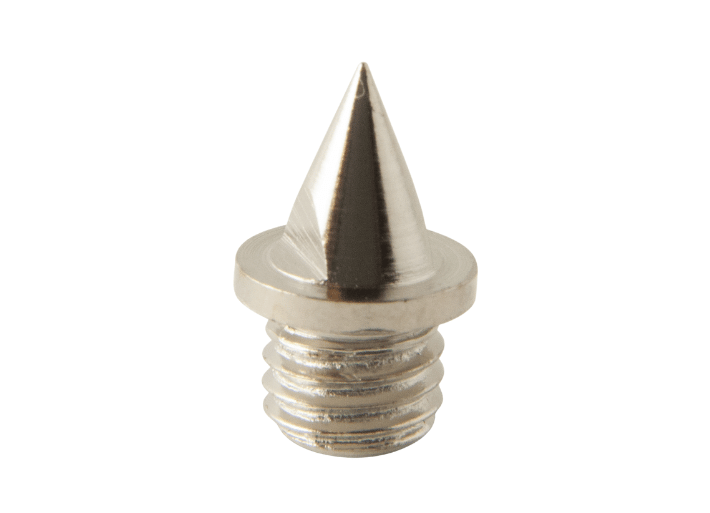
Equipment for Long Jump: 2023 Edition
BY RUBY JERGES
Having been a long jumper for a good few years now, I have sometimes underestimated the importance of specific equipment that is required for the discipline. However, in more recent years, and as I have spent more time by the pit, it has become increasingly apparent how essential having the right equipment truly is.
Why do I say this? As you improve as a jumper, even the tiniest of margins can and will contribute to you producing your best performance. In long jump, where every centimetre counts, having the right equipment may be the difference between gold and silver and a jump or a no jump.
Below, I will share with you some examples of the equipment used in long jump. I have my personal preferences (which I will also discuss in this blog), and I'll give you a few practical tips to provide further insights into long jump should you choose to make any adjustments (large or small) to the equipment you use.
MASSAGE ROLLERS FOR JUMP ATHLETES

The first piece of equipment I'm going to talk about is rollers. These are hugely beneficial for jumping athletes, particularly in warmups/cool downs and recovery.
In warmups and cool downs, rollers help to increase the warmth of muscles and their range of movement while also loosening any knots an athlete may have.
By adopting a forward and backward motion for around 30 seconds in each area, foam rollers are an instrumental piece of equipment as they prepare us for exercise and help us to loosen up a bit. I always take mine to training and competitions and make sure I use it both before and after the competition.
It has become an essential piece of kit for my routine, and I use the time I spend with rollers to mentally prepare for my performance or reflect on previous performances.
I would recommend this Deep Massage Roller in particular!
RESISTANCE BANDS FOR JUMP ATHLETES

The use of resistance bands effectively enhances mobility for athletes, while they are also good at increasing strength and tone of muscles. They can be implemented into circuits during training sessions where the resistance adds greater difficulty to the exercises you carry out.
Resistance bands have been a valuable part of my rehab training. As they gently help increase mobility and strength in specific areas. You can be selective and have control over how much resistance to apply when carrying out gentle movements.
Depending on the difficulty or resistance you wish to add to your exercise, there is a wide range of different resistances you can choose from, ranging from thick bands to thin ones and long bands to short bands.
These Dynabands come in four different strength grades, and are perfect for training, recovery and physiotherapy!
LONG JUMP SPIKES

When I started out as a long jumper, I was surprised to find out about the difference between regular sprint spikes and long jump spikes!
I have now learned that the main difference between the two is in the design and structure of the shoes. As a large amount of force is exerted using a flat foot in long jump, jump spikes have a more rigid makeup which provides the jumper with as much heel support as possible (particularly for the take-off of the jump). Regular sprint spikes do NOT offer this.
It is important to find shoes that fit you and work for your technique. I recommend experimenting wherever possible. You could ask a friend about the spikes they use or go to your nearest store and try on several pairs yourself!
I have experimented with a wide range of styles, but I currently use the Nike Air Zoom spikes. I have found these spikes give me support and spring in my run-up.
Whilst I strongly recommend these spikes, please remember that everyone is different, and there are other options. I have also heard positive feedback about the Adidas Adizero Long Jump spikes and Adidas Jumpstar Shoes.
Disclaimer: These spike shoes are not endorsed by the Neuff Athletic team, and are only recommendations based on Ruby's previous experiences as a long jumper.
WHAT ARE THE BEST LONG JUMP SPIKES?

Here are some of my main pieces of advice when it comes to choosing and owning long jump spikes:
- Go with a brand you are familiar with, as you are more likely to be familiar with the sizing and the shape of the shoes.
- Avoid anything too big (obviously!). Doing this helps you avoid tripping over your own feet and may even make you less likely to no jump.
- Equally as obvious; make sure they aren't too small. Your foot needs support but doesn't need to be rubbing. If this happens, you can subconsciously adapt your stride (not something you want to do on the runway!).
- When putting new spikes into the shoe, use Vaseline around each spike. This makes them easier to remove and put back in when they need to be changed.
- When getting a new size of spikes, and if you use pigeon steps when marking out your run-up, remember to consider that the different shoe sizes will change the number of pigeon steps in your run-up.
- When at a higher level (and you're able to afford it), it is often helpful to have two pairs of the same spike (one for training and one for competing). This avoids wearing out competition spikes while practising in nearly the same shoes during training.
LONG JUMP MEASURING EQUIPMENT

Whilst some may think it is only in competitions that measuring tape is used, it is beneficial that you, the athlete or your coach, always have a roll of this during training sessions and competitions.
I say this as it can be used not only to mark out your run-up (alongside the run-up, giving measurements accurately in metres) but also to measure jumps in practice (great for seeing the progress you are making) and to set up drills of certain distances (for example if you are using mini hurdles or cones).
Many athletes use measuring tape to mark their run up out in metres rather than pigeon steps. This has its benefits, as using a tape measure is quick and easy to set up during competition. It also means that you are less likely to measure it out wrong, as the measurement always starts from the same position on the board.
On another note, if your mark is accidentally moved, you can reset the positioning quickly and reliably using the tape measure if it is still beside the run-up. However, only some competitions will have a tape measure available when needed. Therefore, it is sensible to know your run-up in pigeon steps (just in case!).
RUN-UP MARKER TAPE FOR LONG JUMP

Using tape to mark the start of your run-up is quite a self-explanatory use of this piece of equipment. However, since learning more about the different phases of the run-up, this tape can be used not only at the start but also in other parts of the run-up.
THE 3 PHASES TO A SUCCESSFUL LONG JUMP RUN-UP
- The acceleration phase - the drive at the start of your run-up.
- The alignment phase – the part towards the middle of your run-up where you hit optimal speed and are fully upright
- The attack and set up of the take-off phase – where you prepare to jump in the last six or so strides.
In training, marker tape can help you isolate each of these phases, which is hugely helpful as you look to improve or deal with inconsistencies.
Taking an example from my own experiences, I went through a period of getting no jumps frequently. Working with my coach, we recognised it was down to the inconsistency of my run-up, meaning that the stride length or attack I was giving to each phase was different between competitions, resulting in inconsistent positioning on the board.
To ensure that I was hitting each phase correctly, we used tape on the run-up, in line with where I should be hitting each phase, such as the drive phase. By doing this, we were able to assess my positioning when looking back at videos of jumps and adjust accordingly.
The above is a handy tip for all aspiring long jumpers, as positioning can be compared to the mark you aim for, and necessary adjustments can be made to ensure each phase is being executed in the next round. You will need to consider that some competitions only allow a maximum of two markers to be set up on the run-up per athlete. This can be a technique to work on in training to be perfected and ready for your competitions!
RUN-UP/JUMP MARKERS

While tape has benefits, I also suggest using a personalised colour marker to mark your run-up. This is because, particularly in rainy weather conditions, the tape may not stick down as effectively as you would like and could get stuck to an athlete's spikes.
Having experienced this myself in competition, I always use one of these markers and my tape. It stops other athletes from inadvertently moving my marker and throwing my run-up into turmoil!
JUMP FAR WITH THE RIGHT EQUIPMENT!

I hope the advice and experiences I have shared will be useful to you! Each piece of equipment discussed is optional, depending on an athlete's preferences and how seriously you want to take the discipline.
As mentioned at the start, even the slightest improvement or addition to your kit bag can make a difference, and you never know where that will take you.
If you're considering purchasing any of my suggestions (all of which are available on Neuff's website), then make sure to use my code 5RUBYJ for a 5% discount at the checkout!
ABOUT RUBY JERGES

Ruby is primarily a long jumper, but is also known as a sprinter!
She started doing gymnastics for a little while at just five years old, but then realised in secondary school that athletics was what she wanted to pursue.
Ruby loves to inspire young girls in getting involved with athletics, and is keen to start writing for us!
She competes for Crawley AC, as well as for Loughborough University.
Instagram: @ruby.jerges


Leave a comment